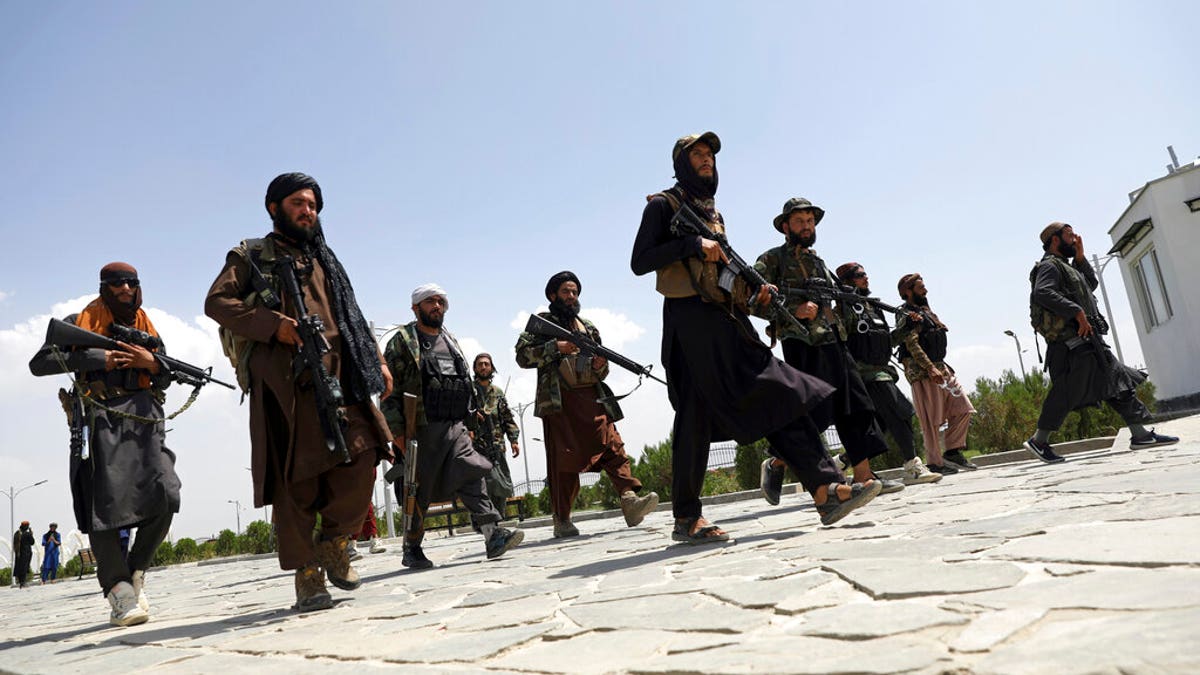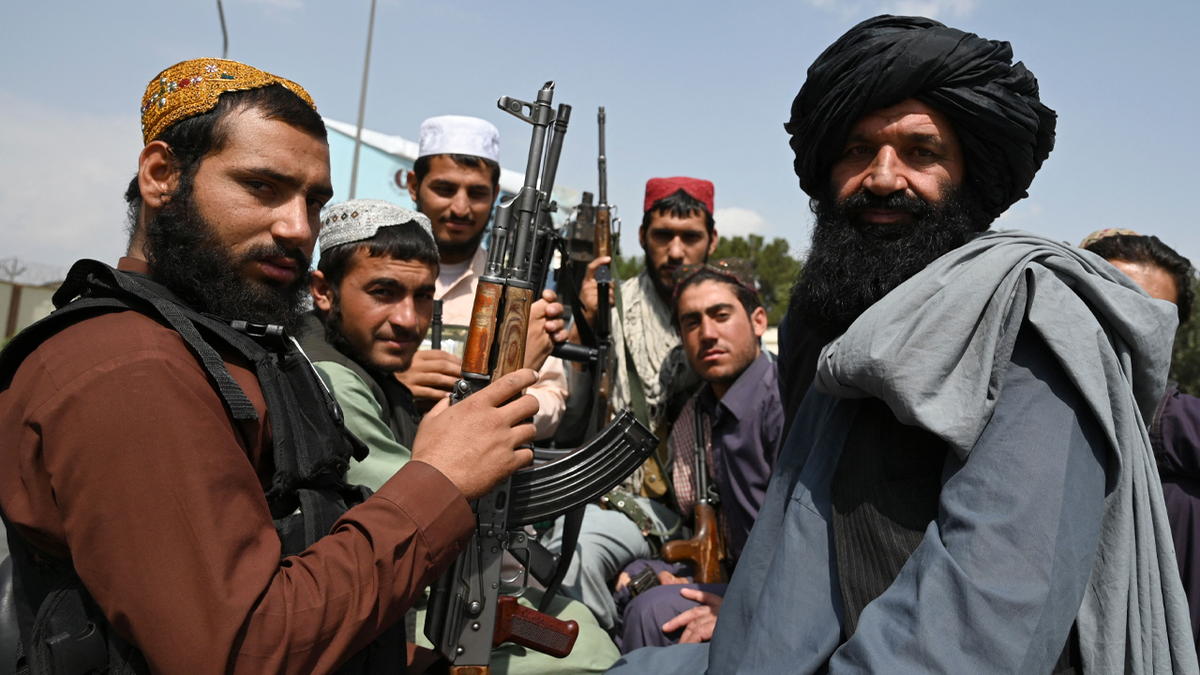Pentagon says working with the Taliban is ‘possible’
Rep. Dan Crenshaw, R-Texas, on top Pentagon officials claiming it is ‘possible’ the United States will work with the Taliban against ISIS-K in Afghanistan.
U.S. troops destroyed or disabled nearly 100 combat vehicles and dozens of aircraft before vacating the airport in Kabul on Monday, in a last-ditch bid to deprive the Taliban of the use of some American military equipment.
But now that all U.S. forces have left Afghanistan, defense officials, lawmakers and experts who track the flow of weapons are watching closely to see what becomes of the acres of weaponry, vehicles and aircraft that were left behind, are still operable and can be of use to the Taliban or to arms smugglers.
Oryx, a blog that verifies military equipment using photos and videos, has identified 38 airplanes, 13 helicopters and seven unmanned aerial vehicles that the Taliban has captured in working order.

In this Aug. 19, 2021, file photo, Taliban fighters patrol in Kabul, Afghanistan. After the Taliban takeover, employees of the collapsed government, civil society activists and women are among the at-risk Afghans who have gone into hiding or are staying off the streets. (AP Photo/Rahmat Gul, File)
The total stockpile is likely much larger. The Taliban inherited thousands of U.S.-supplied assault weapons and military ground vehicles along with other technology and equipment including artillery pieces and night-vision goggles, another toll of the U.S. troop withdrawal and the collapse of the U.S.-backed Afghan National Security Forces.
This week, videos and photographs circulated on social media showing a U.S. UH-60 Black Hawk helicopter flying in Afghanistan, the first such images hinting at new Taliban combat air capabilities.
A group claiming to represent the Islamic Emirate of Afghanistan, the Taliban’s name for the country, was among those that published the video, with an accompanying message: "Our Air Force! At this time, the Islamic Emirate’s air force helicopters are flying over Kandahar city and patrolling the city."
QATAR SAYS IT'S NOT CLEAR WHEN KABUL AIRPORT WILL REOPEN
Another video showed a helicopter, trailing a Taliban flag, flying over a convoy that included what appeared to be seized U.S. military vehicles and equipment.
The Wall Street Journal couldn’t independently verify the authenticity of the videos, the location of the flights or the affiliation of the pilots. A Taliban spokesman said in a text message to the Journal that more details would be available later.
"Now, these are initial days," said the spokesman, Suhail Shaheen. "When the new [government] is announced, more details about military hardware will be known."
Washington spent more than $80 billion over 20 years on the Afghan military and police, U.S. government auditors have said, a portion of it in armaments. U.S. officials have said they have no reliable accounting of Taliban weapons seizures.

Taliban fighters sit in the cockpit of an Afghan Air Force aircraft at the airport in Kabul on August 31, 2021, after the US has pulled all its troops out of the country to end a brutal 20-year war -- one that started and ended with the hardline Islamist in power. (WAKIL KOHSAR/AFP via Getty Images)
"We are not concerned with the loss of any significant technological or sensitive capability," Eric Pahon, a Pentagon spokesman, said. "While seizing this equipment may be beneficial to the Taliban, it does not represent a threat to the U.S., allies or partners."
Numerous images have emerged of Taliban fighters dressed helmet to boots in U.S. Special Forces gear, holding U.S.-made assault and sniper rifles.
After the completion of the U.S. troop pullout on Monday, videos and photos showed Taliban fighters at Hamid Karzai International Airport in Kabul inspecting a haul of aircraft, including Chinook helicopters and a C-130 heavy-lift cargo plane.
US MILITARY ESCAPE FROM AFGHANISTAN: AIR FORCE CREWS DESCRIBE ‘APOCALYPTIC’ FINAL SCENES
Marine Corps Gen. Frank McKenzie, the head of U.S. Central Command, said Monday that his forces had disabled around 100 military ground vehicles and 73 aircraft. In some cases, personnel drained oil and transmission fluid from vehicles or aircraft and ran their engines until they seized up, rendering them useless, a U.S. official said. On others, electronic systems were smashed, the official said.
Military experts have played down the likelihood of any lasting value of functioning aircraft seized by the Taliban, since complicated maintenance operations have been performed by contractors who have now left the country.
"The ability for those birds to continue to fly in the long term is going to be very challenging," said John Venable, a former Air Force officer who led combat flights in Afghanistan, now at the Heritage Foundation think tank. "It’s spare-parts reliant, and that flow was cut off."

Taliban fighters sit on the back of a pick-up truck at the airport in Kabul on Aug. 31, 2021, after the US has pulled all its troops out of the country to end a brutal 20-year war -- one that started and ended with the hardline Islamist in power. (WAKIL KOHSAR/AFP via Getty Images)
Some analysts nonetheless emphasize that nations friendly to the Taliban could assist the group in helping extend the use of planes and helicopters by supplying parts, maintenance or pilots.
Some U.S.-trained Afghan air force pilots remain in the country, prompting concern that these airmen are at the controls of the recent helicopter flights, possibly under duress.
"You’re watching the worst kind of coercion take place right now," Mr. Venable said. "If you take a gun and hold it to one of their family members, it’s, ‘Yeah, I’m going to fly that helicopter for you.’ "
MAINSTREAM NETWORKS ABC AND CBS NIGHTLY NEWSCASTS SKIP LEFT-BEHIND AMERICANS IN AFGHANISTAN
Last month, hundreds of Afghan service members flew to neighboring Uzbekistan on nearly 50 Afghan Air Force aircraft.
Bowing to Taliban pressure, the Uzbek government has told the U.S. that these pilots soon will have to leave the country.
A group of U.S. lawmakers including Mike Waltz (R., Fla.), a former Green Beret who served multiple tours in Afghanistan, is attempting to redirect these aircraft and pilots to Afghanistan’s Panjshir Valley to support a possible fight led by Afghan forces that oppose Taliban rule.

Taliban fighter stand guard at a checkpoint near the gate of Hamid Karzai international Airport in Kabul, Afghanistan, Saturday, Aug. 28, 2021 (AP Photo/Wali Sabawoon)
The Taliban is expected to sell a portion of the arms and military equipment it has seized, as the U.S. freezes Taliban-related assets, arms analysts say. Studies including a 2012 paper by Small Arms Survey, a Geneva-based defense research group, have identified longstanding arms smuggling routes between the Taliban and people in Iran, Pakistan and Tajikistan.
"These newly seized weapons can follow existing routes to flow throughout Afghanistan and beyond its borders," said Lauren Woods, the director of the Security Assistance Monitor, part of a Washington think tank. "Our weapons monitoring and inventory processes are insufficient to prevent them from being diverted and misused."
CLICK HERE TO GET THE FOX NEWS APP
However, the immediate hoarding of weapons may more adequately suit the Taliban’s near-term goal of consolidation, Mr. Waltz said.
"Having a lot of stuff equals power," Mr. Waltz said. "I see them holding on to it and preparing for what’s to come."
To read more on The Wall Street Journal, click here.

